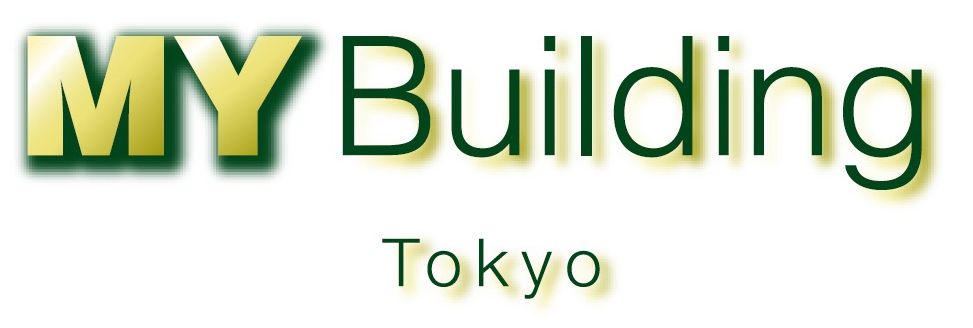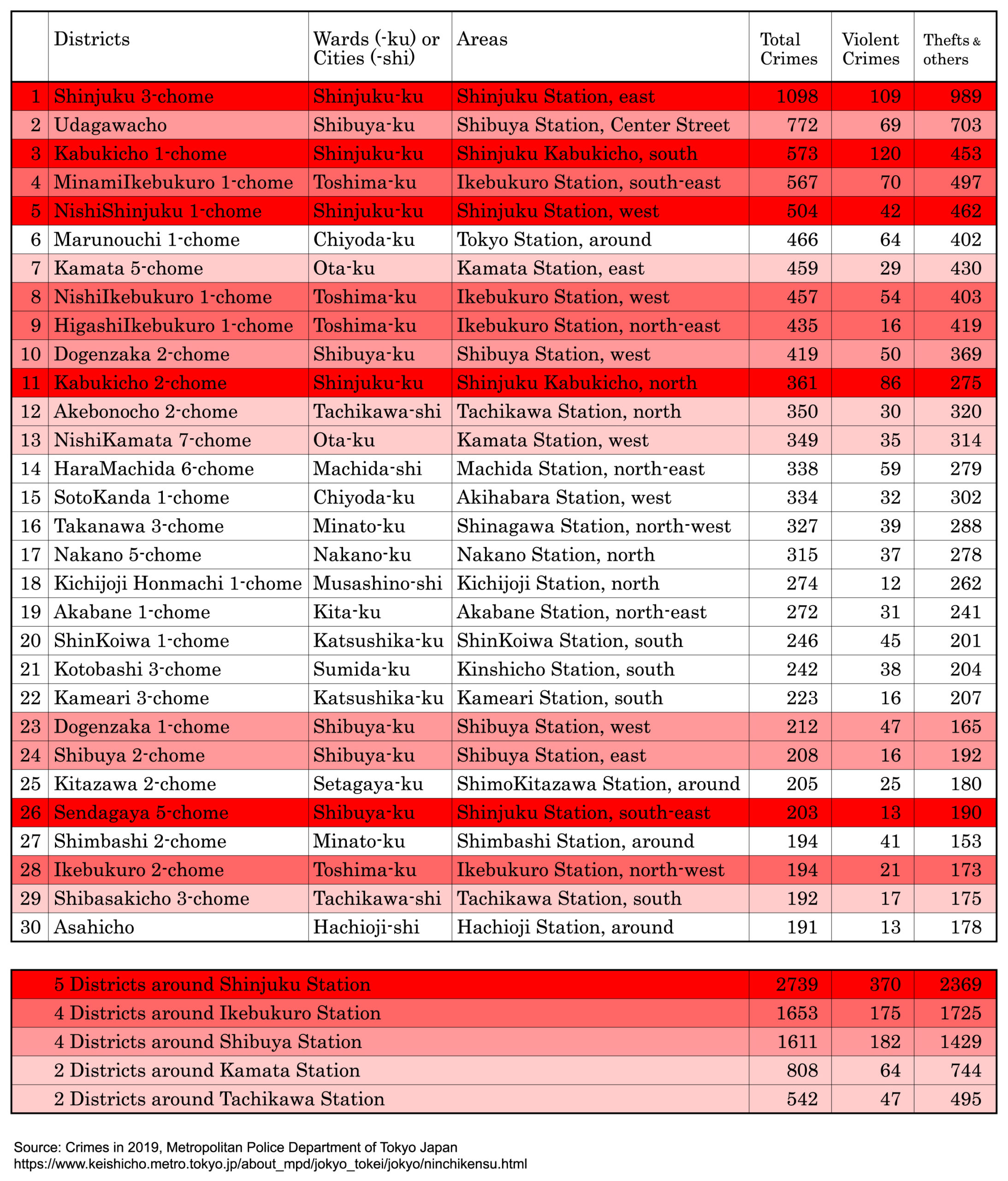Dangerous Areas in Tokyo

30 Most Dangerous Districts in Tokyo
Based on crime data by the Police Department of Tokyo in 2019

As you can see, the crime statistics of Metropolitan Police Department of Tokyo in 2019 shows that Shinjuku, Ikebukuro and Shibuya are the 3 most dangerous areas in Tokyo by far, as we all know the famous Shinjuku Kabukicho, Ikebukuro “West Gate” Park and Shibuya Center Street.
Tokyo locals also know about Kamata (a comedian who said “Kamata is Hell” has vanished), Tachikawa and Machida (both are called “western Kabukicho”), especially around the stations.
Big towns like Tokyo Station area, Akihabara, Shinagawa and Shimbashi’s crime stats rise obviously as the number of people increases significantly in the daytime. New towns like Nakano, Kichijoji and ShimoKitazawa’s crime stats rise as more and more people move there from other prefectures recently.
After #30, this ranking is followed by Ueno (big town), Mitaka (new town), Takadanobaba (big town), Omori (near Kamata), Harajuku (big town), Tama Center (new town), Yurakucho (big town), ShinOkubo (Korean town), Kameido, Nishiarai, Hikarigaoka, Roppongi, Sangenjaya, Ginza and so on.
Some websites show “crime rate by ward”, but it does not show the actual state of affairs. According to the “crime rate by ward” in 2019, Chiyoda-ku is the top 4.72% (this is quite odd), more than double of the second Shibuya-ku 2.11% and the third Shinjuku-ku 1.72%, but it has a trick: a crime rate is calculated by dividing the number of crimes (daytime and nighttime) by the total population (only nighttime).
Some wards in central Tokyo like Chiyoda-ku have smaller land area and much smaller population than new big wards like Ota-ku (see the map here for land area, population: Chiyoda-ku 61k, Shinjuku-ku 343k, Ota-ku 728k, Setagaya-ku 921k), and have some big stations and big towns. So in Chiyoda-ku, the number of crimes increases as the number of people in the daytime increases much higher than the population, then if you calculate the crime rate by dividing the number of crimes by the small population, the crime rate will look like much higher than actual.
The actual number of crimes by ward, top 5 are: Shinjuku-ku 5898, Setagaya-ku 5221, Ota-ku 5031, Shibuya-ku 4851 and Adachi-ku 4764, that makes sense. Followed by Edogawa-ku, Nerima-ku, Toshima-ku, Itabashi-ku, Minato-ku, Hachioji-shi, Koto-ku, Katsushika-ku, Suginami-ku, the 15th is Ciyoda-ku 2896 and the 16th is Taito-ku.
And others try to calculate a crime rate by dividing the number of crimes (daytime and nighttime) by the total population (only nighttime) plus the daytime population estimate, but the estimate is not accurate as you can imagine: the daytime population fluctuates greatly on an hourly basis due to daily events in the small wards in central Tokyo, it is extremely difficult to grasp the population movement between small wards.
Kamata, Tachikawa, Machida, ShimoKitazawa, Hachioji, Akabane, Shinkoiwa, Kinshicho, Kameari, Setagaya-ku and Suginami-ku used to be famous for “Yankii” (Japanese delinquent youth) or “Bosozoku” (motorcycle gangs), but now they are decreasing in these days after their peak in 80s (You can still see them in Ibaraki, Fukuoka, Chiba, Okinawa, Osaka, Kanagawa and Hiroshima).
But still now, “Hangure” (quasi-gangsters) gangs keep on growing behind the legal system around certain places. They are mainly made up of former and junior members of motorcycle gangs and people from East Asia. They often run bars, clubs, restaurants, or real estate businesses. Crime figures in Roppongi and Nishi-Azabu are not so bad, but most Tokyoites say this area and the surrounding Minato-ku are “really dangerous places in Tokyo” (dangerous in terms of drugs and unconscious funding of Anti-Social Forces). For example, The U.S. Embassy is warning its citizens to watch out for drink spiking in Roppongi.
Travel.State.Gov, U.S. DEPARTMENT of STATE – BUREAU of CONSULAR AFFAIRS officially says:
“Exercise caution in all entertainment and nightlife districts throughout Japan, especially Roppongi, Kabuki-cho, Shibuya, and Ikebukuro.”
“Please be aware that Roppongi, Kabuki-cho, and other entertainment and nightlife districts have also been the scenes of violence between criminal syndicates.”
It is difficult to judge which bars are associated with Yakuza gangs, Hangure semi-gangsters, or vicious land speculators, but the high prices may be one indicator. Places where you need to be especially careful are host and hostess clubs. (By the way, be careful of the Pachinko, too.)
They are often wealthy, often wear expensive watches and often use “upscale residential areas” where the number of vacant houses has increased in recent years and they are becoming hotbeds of crime.
Also, regarding lodgings and accommodations, it is an obligation established by the Japanese government to request a copy of the passport of foreigners who do not have an address in Japan. Any lodging that does not ask you to provide a copy of your passport is likely an illegal lodging. There are also increasing cases of such illegal lodgings becoming hotbeds of crime.
In Japan, tattoo is the most typical sign of being a Yakuza or a Hangure, so tattooed person is not allowed in most spas, swimming pools, beaches and amusement parks, in order to show solidarity against Anti-Social Forces. The dilemma is that most Japanese would like to welcome the “tattooed foreign tourists” who are not gangsters obviously, but it might be difficult to make a rule that says “tattooed Western person who looks like a tourist is allowed but tattooed East-Asian person who looks like a Yakuza or a Hangure is not allowed”.
In recent years, crimes committed by foreigners have been increasing rapidly. In the first place, the number of foreign members in organized crime, Yakuza and Hangure gangs is large and continues to increase.
In Greater Tokyo Area, Kawasaki-ku of Kawasaki-shi in Kanagawa Prefecture, Kawaguchi-shi in Saitama Prefecture, and Matsudo-shi in Chiba Prefecture are notorious for being dangerous. Kawasaki-ku is adjacent to Ota-ku, Kawaguchi-shi is adjacent to Kita-ku and Adachi-ku, and Matsudo-shi is adjacent to Katsushika-ku.
Asakusa was the most prosperous town that existed since the 7th century. From the Edo period (1603-), Asakusa, Ueno and Nihonbashi have been centers of Tokyo. From 1920s Ginza, from 1970s Shinjuku, Shibuya and Ikebukuro, and from 1980s Roppongi started to flourish as new city centers. So some elderly and rural Japanese people tend to misunderstand Asakusa and Ueno as “dangerous” still now. On the other hand, young Tokyoites who understand the current situation say “Roppongi, Nishi-Azabu, and the surrounding Minato-ku areas are the most drug-soaked and notorious areas in Tokyo”.
But overall, Tokyo is safe. Walking at night is normally safe almost everywhere even in Shinjuku Kabukicho or Roppongi, all you have to do is to ignore the honeyed words and the touts (even touts are decreasing due to police efforts recently). And don’t buy anything from people on the street who approach you and try to sell you something, like fake monks on the street who will hand you charms and force you to pay. Real monks will never approach you, never sell anything on the street.
And Tokyo’s crime rate tends to be lower than Osaka and Fukuoka, and Japan’s crime rate is very low as you can see here: How Safe is Japan?
And as you can also see, the data shows most of those dangerous districts are adjacent to the big stations. If you stay a little distant from those stations, you are quite safe. Even in Shinjuku-ku, west half has some big JR stations and it is rather dangerous, but east half used to be Edo city area and it is quite peaceful.
